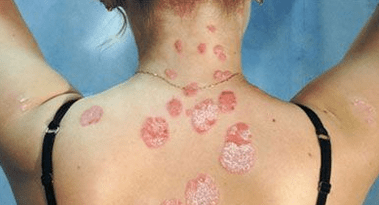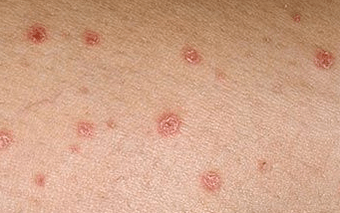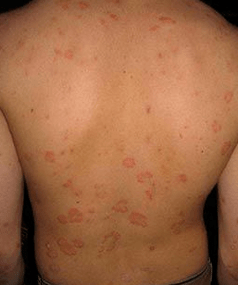Psoriasis is a chronic, non-communicable, skin disease that primarily affects the skin.Currently, it is assumed that the disease is autoimmune in nature.Typically, psoriasis manifests itself as red, excessively dry, raised spots on the surface of the skin, called papules, that merge into each other to form plaques.These papules are essentially sites of chronic inflammation and excessive proliferation of cutaneous lymphocytes, macrophages, and keratinocytes, as well as excessive angiogenesis (the formation of new small capillaries).

It occurs equally frequently in men and women and lasts for several years, with alternating periods of relapse and remission.This is one of the most common, difficult to treat, and often serious skin conditions.
What is psoriasis?
Psoriasis is a widespread, chronic skin disease characterized by monomorphic flat papular rashes that often coalesce into large plaques that are quickly covered by loose, silvery-white scales.
Psoriasis is characterized by exacerbations (relapses) and temporary well-being, when the manifestations of the disease become less severe.The disease is not contagious and patients do not pose a risk to others.Because the occurrence of psoriasis has nothing to do with microorganisms.
Psoriasis is primarily characterized by a single pink or red papule covered with large amounts of loose, silvery-white scales.
Usually, psoriasis does not disrupt the patient's normal rhythm of life.The only inconvenience is skin peeling and inflammatory processes.Unfortunately, there is no cure for this disease, but it is possible to halt its progression or prevent recurrence.To do this, it is enough to follow all the doctor's prescriptions and receive systematic treatment in the hospital.
Is psoriasis contagious?
Psoriasis is absolutely not contagious.There has not been a single case of human-to-human transmission of the disease recorded.The disease is caused not by infections and microorganisms that are potentially dangerous to others, but by white blood cells produced in the patient's body.
It is impossible for a healthy person to contract psoriasis from a sick person.Psoriasis does not spread:
- If contact occurs on skin, use the same household items (sheets, towels, dishes) as the patient.
- Through saliva, sweat.
- Sexually.
- When caring for patients.
- Through blood.
Classification
Experts distinguish two forms:

non-pustular psoriasis
what is it?What sets this disease apart from others is its stable course.Non-pustular psoriasis is characterized by damage to nearly the entire body surface.This type includes:
- Erythrodermic psoriasis
- Vulgar, plain or blank.
Vulgar psoriasis is common; up to 90 percent of people with psoriasis have the vulgar form of the disease.
Psoriatic erythroderma is a serious disease that often leads to fatal consequences - death of the patient.With the onset of the disease, the thermoregulatory function is violated and the barrier function of the skin is reduced.
Pustular type
- Pustule background Zumbusch or pustules all over the body
- Palmoplantar pustulosis (pustular psoriasis of the extremities, chronic persistent palmoplantar pustulosis)
- annular pustules
- palm sole
- psoriasis herpetiformis impetigo
| psoriasis stages | damage percentage |
| lightweight | Less than 3% of the skin is affected |
| average | 3-10% of skin is covered by psoriasis plaques |
| Heavy duty | There are joint lesions or more than 10% of the skin is involved. |
How Psoriasis Starts: The First Signs
In most cases, identifying psoriasis is easy because the disease does not resemble other skin conditions.Allergic rashes are less calibrated than psoriasis spots, and the history suggests patients don't actually experience skin swelling as with allergies
The initial signs and symptoms of psoriasis vary based on the key features doctors rely on in making the diagnosis:
- Limited pink spots of varying intensity appear;
- Itching of the skin in areas of psoriasis lesions;
- A large number of epidermal sloughs of varying sizes;
- Characteristic white flaking color;
- The appearance of clusters of off-white or gray scabs that do not extend beyond the borders of psoriasis spots;
- Dry skin.
Psoriasis has three distinctive characteristics:
- "Stearic acid staining effect." When scraping plaque, the small, transparent scales peel off easily.
- "Terminal Movie Effect".If the scales are removed, the skin in this area will become thin, shiny, and red.
- "Blood effect." Tiny droplets of blood appear on the skin after scratching.
reason
Experts are unable to identify the exact and sole culprit for the disease, but repeated studies have shown that the disease is autoimmune, meaning it relies on the function of the immune system.
For some unknown reason, immune cells designed to protect the body from malignant changes and bacterial and viral damage penetrate the upper dermis and produce substances that trigger the inflammatory process.The result of this activity is proliferation - the accelerated division of skin cells.

According to another theory, psoriasis occurs due to disruption of the keratinocyte life cycle.
Possible causes of psoriasis:
- genetics.According to the latest data from scientists, psoriasis is classified as a genotype skin disease that is mainly transmitted through transmission.
- Violation of lipid, protein and carbohydrate metabolism.When cutaneous psoriasis is suspected, these hematological signatures are often altered, which can contribute to the development of cardiovascular pathology, endocrine dysfunction, and metabolic syndrome.
- There are chronic infection foci in the body.Streptococcus bacteria are often detected when examining psoriatic plaques.The development of genetic abnormalities may be influenced by viral and bacterial infections, such as tonsillitis, influenza.
- Climatic conditions - dry and hot weather can influence the progression of psoriasis, exacerbating skin symptoms or, on the contrary, weakening them;
- Anxiety or Stress – As mentioned above, stress and excessive exertion directly affect the course of psoriasis;
- Skin lesions - wounds are susceptible to infection, which leads to inflammatory processes that lead to poisoning of the body, so the appearance of psoriasis may cause minor lesions, but only if there is a concomitant disease;
- Infection - Outbreaks of psoriasis may be caused by the presence of areas of pathogenic purulent inflammation, especially with lesions of childhood.
One theory suggests that there are two variants of the disease:
- Type I psoriasis– Inherited in the presence of immune factors, more than 60% of all patients under the age of 30 have this form, the prognosis is good and treatment is lifelong.
- Type II psoriasis– Occurs more commonly over age 45, is not associated with immune system malfunction, and most commonly affects the nail plate and joints.
Symptoms of psoriasis
Skin psoriasis can occur at any age.But the first cases of its manifestations usually occur in young people and adults aged 18 to 40 years.There are no differences between genders.Men and women suffer from this disease with equal frequency.
| Signs of Psoriasis Papules | |
| form | round |
| edge | clear |
| color | bright pink or red |
| Scale color | Silver white |
Typically, the initial rash appears on cuts, scratches, frostbite, burns, and areas of the body that are subject to frequent friction.They may be itchy, but this is not the main symptom.
Depending on the characteristics of the rash, psoriasis is divided into the following forms:
- Gutate Psoriasis - The size of the element is smaller than the head of a pin.
- Teardrop-shaped papules are tear-shaped and the size of lentils.
- Coin-shaped - plaques up to 3-5 mm long with rounded edges.
The forms of the rash are also easily distinguished when the elements of the rash look like rings, arcs and garlands, geographical maps with jagged edges.

The overall clinical presentation and symptoms of psoriasis vary greatly depending on the stage of the disease.Dermatologists distinguish three sequential stages of development:
- Enterprising.New lesions appear constantly and existing plaques actively spread, with severe peeling and itching.
- fixed.The growth of papules on the body stops slightly, new formations do not appear, but thickened folds appear on the surface of the skin near the plaques.
- return.No increase in disease transmission and peeling was observed.As psoriasis symptoms subside, areas of visible pigmentation remain on the body.
The alternation of these phases results in the wave-like nature of relapses and remissions.Different areas of skin in a patient may be at different stages of the disease.
The early stage of psoriasis is the appearance of papules, which are small scaly nodules.They are dark pink in color, dense to the touch and slightly above the surface of the skin.
The first symptom of psoriasis may be a rash on the areas of the body most exposed to friction, and dry skin in those areas.These places are:
- Palm or elbow;
- below the knee;
- calf;
- outer part of the lower back;
- inguinal folds;
- scalp.
The initial stages of psoriasis are barely noticeable on the skin and cause no discomfort to the patient.But early treatment will help avoid severe forms of the disease, which affects the nails, mucosal surfaces of the hands and feet, and then the joints of the body.
Statistically, psoriatic plaques are most commonly found on:
- on the outer surface of the joint;
- back and abdomen;
- On the front of the thighs and forearms.
This is different from eczema, where the rash affects the folds on the inside of the limbs and between the fingers.























